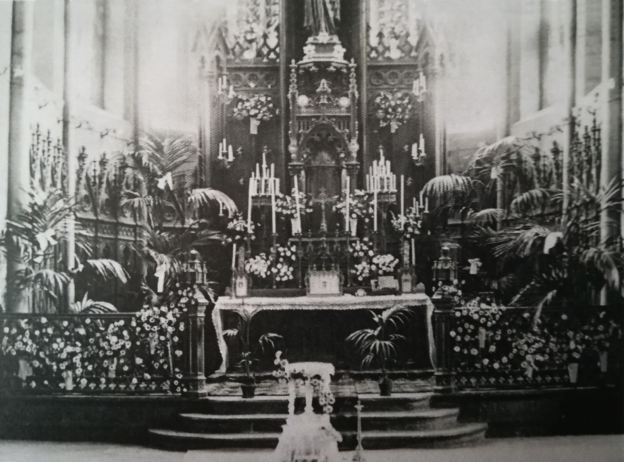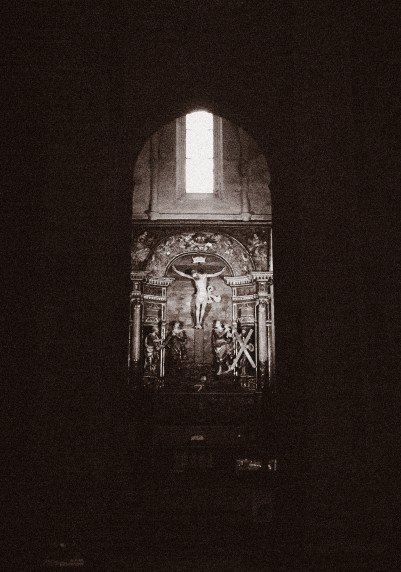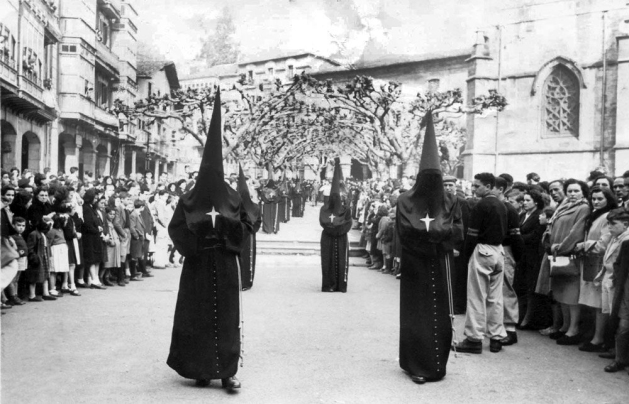Dear visitor, you enter the church of Saint Severinus, a temple that has been visited for centuries by hundreds of travelers and pilgrims looking for moments of peace, recollection and prayer. The foundation of Balmaseda was in the year 1199 and has the honor of being the oldest town in Biscay. Centuries before, it was the nerve center of the trade between the sea and the plateau, and also among the pilgrims on the way to Compostela.

Upon entering, your first glance is directed towards the chapel of the Holy Christ that is in front of you, in the opposite nave. We invite you to start your visit by going to the feet of the nave, leaving the visit to the noble chapel for later. Next to the entrance, there are Gothic tombs where the Lords of Bortedo, founders of the town, rested. We continue the tour arriving at the west gate and on your left; you can find a small Marian chapel, with carvings of Our Lady of Begoña, Our Lady of the Pillar and Our Lady of the Miraculous Medal. They are simple images, but of great popular devotion. The inhabitants of Balmaseda have the same devotion for the son of the village, Blessed Pedro de Asúa, architect, priest and martyr, in whose chapel at the back of the nave of the Gospel one of his relics is preserved.

Go to the head of the church. Do it down the center aisle. From here you can appreciate the Gothic structure, admirable for its coherence and sobriety, distributed in 3 vaulted naves of different heights and supported by 6 slender columns arranged in 4 sections. At your back, you can see the magnificent rosette with a five-pointed star over the valuable French organ, donated by Mr. Martin Mendía, a native “indiano” of the town who made his fortune in Mexico and whose monument you may have seen in the square, before accessing to the temple.

“So I tell you to ask and you will receive, search and you will find, knock and the door will be opened for you. Everyone who asks will receive, everyone who searches will find, and the door will be opened for everyone who knocks.”
Saint Luke 11, 9-10
You arrive at the head of the church, which, as is usual in Christian temples, is oriented to the east, because from the east the sun rises that is a symbol of Christ and that, like Christ, illuminates us and gives us life. The altar is chaired by Saint Severinus, patron saint of the town. He was Bishop of Treveris, city from which he had to flee to Bordeaux in the year 407 to escape the barbarian invasion. There he was warmly welcomed by Bishop Armand, but the Bordelais consider him as their own bishop thanks to the charity and wisdom of Severinus. His remains rest in the basilica of Saint-Seurin in the city of Bordeaux. Devotion to the saint must have arrived with the Aquitanians, the first settlers of the town, in the 8th century or, later, by Frankish devotee pilgrims from Severinus who were going to the city of Compostela. Both are the most plausible hypotheses. His party is celebrated with great fervor on October 23.
Light, understood as a symbol of divinity, is a fundamental element of Gothic architecture. That light penetrates through the 7 large bays of the apse with two rows of images. Let’s identify the iconography of these beautiful stained glass windows. In the upper row, the whole is dominated by the Sacred Heart of Jesus and the Immaculate Heart of Mary.
Accompanying these figures, the Apostolic College extends from left to right. On the left appear the following apostles: St. Jude Thaddeus, St. James the Lesser, first bishop of Jerusalem and relative of the Lord, St. Bartholomew, St. Simon, St. Andrew represented with a cross in the form of the cross on which he was crucified and his brother, Saint Peter, first Pope with the keys of heaven in his hand.
On the right side, you can contemplate the images of the other 6 apostles. The one next to the Heart of Mary is Saint James, son of Zebedee, whose tomb is the end of the Jacobean route that passes through this town. Next to him, is his brother Saint John, evangelist and the favorite apostle of the Lord. The following figures are Saint Thomas, Saint Matthew Evangelist, Saint Philip and Saint Matthias, disciple and later apostle replacing Judas.
In the bottom row the following saints appear from left to right:
St. Ambrose and St. Gregory the Great, two of the great doctors of the Church; Saint Barnabas and Saint Paul; Saint Joseph and Saint John the Baptist. The central window is occupied by Saint Joachim and Saint Anne, fathers of the Virgin. The line continues with the figures of Saint Zechariah and Saint Elizabeth, parents of the Baptist; the Saint Mark and Saint Luke evangelists; to end with the other two great doctors of the Church, Saint Augustine and Saint Jerome.
“I tell you for certain that before you can get into God’s kingdom, you must be born not only by water, but by the Spirit.”
Saint John 3, 5
After this visual tour to the colorful iconography of the apse, on your right you can see the image of Saint John the Baptist, in whose lower part the baptismal font of the parish is located. On the wall of the nave appear two tombs covered in polished white marble that contrasts with the sober stone of the temple. Similarly, on your left, past the ogival door of the sacristy, you can contemplate Saint Michael Archangel, the most beautiful and oldest carving of the temple, made in 1525. The first chapel of the nave of the Gospel appears near the carving, the chapel of Our Lady of Carmen. It is dominated by a modern image of Our Lady of Carmen and to its right, under a monumental shield, is the niche with the image of Saint Roch, co-patron of Balmaseda, made in the eighteenth century.
Leaving the Carmen chapel and on your right, you find the third Gothic tomb of the temple. It is a sepulcher of the fourteenth century. Although it is unknown who owns it, it is said that it could be Enrique de Lucerga, knight of Balmaseda who together with King James I the Conqueror took part in the capture of Valencia in 1238.

“God did not send his Son into the world to condemn its people. He sent him to save them!”
Saint John 3, 17
The chapel of Saint Christ of the Mercy is the next one you find on this nave. It is the oldest temple chapel and a true wonder of the Renaissance. Go inside it and you will see how the perfect square floor becomes octagonal in its upper part. The chapel is covered by a beautiful star-shaped vault of 8 points of plateresque style. The other jewel that we find is the altarpiece that dominates the chapel. This represents Calvary, the death of Christ on the cross, but not understood as a defeat but as the prelude to the final triumph over death that will arrive on Easter Sunday.
The altarpiece was conceived as a triumphal arch. You can stop in each of the extraordinary pieces. The plinth is composed of 3 magnificent reliefs. The first corresponds to Christ on the way to Calvary and represents the moment of the first fall with Veronica and Cyrene. The central relief is the Resurrection, whose relevance is underlined by its position and its parallelism with the image of the Eternal Father with which it is united by the central cross. The last relief is the Fifth Anguish, when the Virgin faints in front of her Son’s lifeless body.
Over two Corinthian columns, God the Father appears among angels who adore him. Meanwhile, in the corners of the arch, two other angels carry the Lord’s tunic and the column where he was flagellated. This triumphal arch frames the main body of the altarpiece. On a painted background of the city of Jerusalem, the perfection in the forms of the crucified Christ stands out, while the figures of the Virgin and Saint John are agitated by the pain due to the drama of the Cross. Serene and out of the scene we see the brothers Saint Peter and Saint Andrew, perhaps assuming the cross as an instrument of triumph, since they were also martyred in it.

“Our salvation is a gift of the blood of Christ. Everything is a free gift from God and his love for us”
The visit to the temple ends, wishing that your visit was pleasant. But before you continue your journey through your life, we invite you to a moment of recollection in front of the Eucharistic presence of the Lord in the Tabernacle. Living Christ has saved and redeemed us, has given us eternal life and is always at our side. For this, we put at your disposal some prayers that may be useful.
“Prayer is the strength of man and the weakness of God”
Gospel of the day / ROSARY / VIA CRUCIS / VIA LUCIS / VIACRUCIS BALMASEDA
|
MASSES BALMASEDA |
||||||
|
Monday |
Tuesday |
Wednesday | Thursday | Friday | Saturday |
Sunday |
|
19.00 * |
– – – | 19.00 | – – – | 19.00 | 19.30 |
13.00 |
|
* If there is a funeral, Celebration of the Word |
||||||
|
First Sunday of the month: Family Mass |
||||||
|
Third Sunday of the month: Community Mass |
||||||
GOSPEL ACCORDING TO SAINT JOHN (19, 25-27)
Jesus’ mother stood beside his cross with her sister and Mary the wife of Clopas. Mary Magdalene was standing there too. When Jesus saw his mother and his favorite disciple with her, he said to his mother, “This man is now your son.” Then he said to the disciple, “She is now your mother.” From then on, that disciple took her into his own home.
SONNET TO CHRIST CRUCIFIED
I am not moved to love you, Lord,
By promises of paradise;
Nor does the hell that terrifies
Move me to want to sin no more.
You are the one that moves me, Lord,
When to your cross I turn my eyes
To see your wounds, hear insults, lies;
I’m grieved to know you’re dying, Lord.
Your love moves me in such a way
That without heav’n I’d love you still,
And without hell, I’d fear to stray.
I need no goads or giveaway;
For even if my hopes were nil,
I’d love you as I do today.
PSALM 103
With all my heart
I praise the Lord,
and with all that I am
I praise his holy name!
With all my heart
I praise the Lord!
I will never forget
how kind he has been.
The Lord forgives our sins,
heals us when we are sick,
and protects us from death.
His kindness and love
are a crown on our heads.
Each day that we live,
he provides for our needs
and gives us the strength
of a young eagle.
For all who are mistreated,
The Lord brings justice.
He taught his Law to Moses
and showed all Israel
what he could do.
The Lord is merciful!
He is kind and patient,
and his love never fails.
The Lord won’t always be angry
and point out our sins;
he doesn’t punish us
as our sins deserve.
How great is God’s love for all
who worship him?
Greater than the distance
between heaven and earth!
How far has the Lord taken
our sins from us?
Farther than the distance
from east to west!
Just as parents are kind
to their children,
the Lord is kind
to all who worship him,
because he knows
we are made of dust.
We humans are like grass
or wild flowers
that quickly bloom.
But a scorching wind blows,
and they quickly wither
to be forever forgotten.
The Lord is always kind
to those who worship him,
and he keeps his promises
to their descendants
who faithfully obey him.
God has set up his kingdom
in heaven,
and he rules
the whole creation.
All of you mighty angels,
who obey God’s commands,
come and praise your Lord!
All of you thousands
who serve and obey God,
come and praise your Lord!
All of God’s creation
and all that he rules,
come and praise your Lord!
With all my heart
I praise the Lord!
If you are visiting us on Holy Week, you can see how the people of Balmaseda live it with devotion and take part in the «Living Passion» that is already part of the soul of this town. If you are visiting us on other dates, do not forget to plan your next visit for this town for those important dates. Web of Via Crucis of Balmaseda